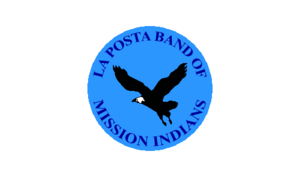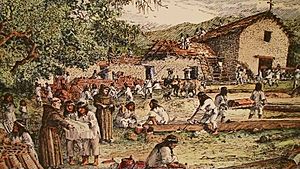La Posta Band of Diegueño Mission Indians facts for kids

Flag of the La Posta Band
|
|
| Total population | |
|---|---|
| 18 enrolled members | |
| Regions with significant populations | |
| United States (California) | |
| Languages | |
| Kumeyaay, Tipai English | |
| Religion | |
| Traditional tribal religion, Christianity (Roman Catholicism) |
|
| Related ethnic groups | |
| other Kumeyaay tribes, Cocopa, Quechan, Paipai, and Kiliwa |
The La Posta Band of Diegueño Mission Indians is a Native American tribe. They are part of the larger Kumeyaay people. This tribe is officially recognized by the United States government. They are sometimes called Mission Indians.
Contents
La Posta Reservation: Home of the Tribe
The La Posta Reservation is the special land set aside for the La Posta Band. It is a federal Indian reservation. You can find it in the southern Laguna Mountains of eastern San Diego County, California. It's not far from the US-Mexico Border.
Size and Location of the Reservation
The reservation is about 3,556 acres (14.39 square kilometers) big. That's like having over 2,700 football fields! Around 18 people live there. The reservation touches the Cleveland National Forest. You can only reach it by one dirt road. This road is often fenced to keep out unwanted visitors.
History of the Reservation Land
The La Posta Reservation was created in 1893. In 1973, none of the tribe's members lived on the reservation. Today, it remains an important part of their heritage.
History of the Mission Indians
The term Mission Indians refers to Native American people in California. Spanish settlers forced them from their homes. This happened in the mid-16th century. The Spanish made them live and work at Franciscan Missions.
Life at the Spanish Missions
There were about 21 Franciscan Missions in California. They stretched from San Jose to San Diego. Many of these large buildings were built by Native tribes. They were forced to work and build these missions. If they didn't, they faced harsh punishments.
Ancient Roots of the La Posta Band
Most Native Americans at these missions were from the local areas. They had lived there for hundreds or thousands of years. The La Posta Band of Diegueño Mission Indians is a group within the Kumeyaay people. Evidence shows that these tribes have lived in California for over 12,000 years. The La Posta Mission Indians share the same family history as the Kumeyaay people. Their traditions come from both the California Coast and Valley areas, and the Desert regions.
Languages Spoken by the Tribe
The La Posta Band Mission Indians speak three main languages. These are English, Kumeyaay, and Tiipai.
Understanding Tiipai and Kumeyaay
The languages they speak depend on where they live. Tiipai is mostly spoken by tribes in northern Baja California and Southern San Diego. This area is also known as Southern Diegueño. The tribe's land is large, about 4,000 acres. Some of their territory reaches towards Yuma, Arizona. Their closest relatives live there. Tiipai is part of the Yuman language family. This is why they use the Southern Diegueño language. The tribe also speaks Kumeyaay. This is because of their shared history with the larger Kumeyaay tribe. They have similar languages, customs, and spiritual beliefs.
Economic Activities
The tribe used to own and run a place called the La Posta Casino. They also had Marie's Restaurant in Boulevard. Both of these businesses closed in 2012.
Education for Tribal Members
The Mountain Empire Unified School District provides education for the tribe. This school district was started in 1923.
Schools in the District
The school district has grown a lot over the years. It now includes:
- Two elementary schools for Pre-K through 8th grade.
- Two elementary schools for Pre-K through 5th grade.
- Two middle schools for 6th through 8th grade.
- One high school.
- An Alternative Education Program.
- A Transition Program for Special Education students aged 18 to 22. This program helps them after high school.



